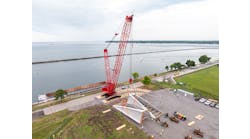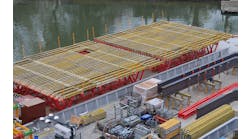By: Kari Moosmann
Pavement management in the broadest sense has traditionally been reactive in terms of pavement preservation—when resources became available, they were used to fix what was broken.
But resources continue to become scarcer while road travel becomes heavier, so there is a pressing need to be ever more strategic.
States began to implement pavementmanagement systems (PMS) more than 30 years ago, so today there are well-established methods of assessing a road network’s needs and budgeting resources accordingly. Most often, specialized computer programs are used to model road conditions and prioritize maintenance and repairs. Concurrent with the development of PMS, concrete pavement-preservation (CPP) techniques were being developed. Today, state departments of transportation (DOTs) employ comprehensive CPP programs that utilize time-tested preservation treatments in order to maintain good road conditions while extending pavement life. PMS places an emphasis on preservation efforts and helps governing bodies stave off the need for extensive (and expensive) repairs, while maintaining a high standard of quality within the road network. The broad focus of PMS is effective at keeping an overall road network in good condition. But computer models and number crunching alone do not optimize road repair.
Face-to-face learning
As pavement-preservation and pavement-management efforts were taking off across the U.S., state DOTs relied heavily upon training sessions that were provided by established contractors and suppliers. Workshops were developed to educate department personnel about new pavement treatments, and these workshops proved to be effective ways of sharing information. Such training partnerships continue to support the adoption of various improvements across the industry today and have recently been extended to the county level. The Douglas County Department of Public Works Engineering in Colorado provides an excellent example of how one county achieved success by inviting industry members to weigh in early and establishing a firm plan before work on their construction project got under way.
In late 2013, Douglas County completed one of the largest CPP projects ever undertaken by a county entity. The urban neighborhood of Highlands Ranch includes businesses and local access to homes, which made for an unusual set of challenges as CPP was conducted across its various arterial and collector roadways.
“While Douglas County does have an aggressive pavement-management program utilizing some of the best management tools, it was a question of the concrete pavement’s age and rideability, or smoothness, that brought this project to the top of their list,” said Darrell Roberts, engineering permits, inspections and utilities manager with the Douglas County Department of Public Works Engineering.
Highlands Ranch had significant stretches of roadway that were reaching the end of their design life, ranging in age from 25 to 30 years old. With this aging pavement, it was critical that the county do some research prior to the project that also included a review of options available to fix the problems. A forensic study was conducted on five different sections of concrete roadways within Highlands Ranch, with one of the sections showing no issues and the remaining four showing issues including broken panels, joint separation, transverse faulting and cracking.
“Once the report became available and the problems were identified, the county held several conferences with different agencies to gain an understanding of options to fix the problems with a long-range goal of reduced maintenance,” said Karl Lucero, pavement-management engineer with the Douglas County Department of Public Works Engineering.
Douglas County has performed CPP in the past on several small areas and achieved good results and was therefore looking to increase the use of CPP and affect a larger percentage of their network using the knowledge gained on those smaller projects. The county chose to make the standard repairs using a remove-and-replace system on all broken concrete with the addition of transverse dowel bars in locations where there were none. Grinding of 500,000 sq yd of pavement, followed by sawing and sealing of 1,058,400 ft of concrete pavement joints, was identified as a second phase of the CPP. The total length of concrete repaired was 66 lane-miles, distributed across two sections with seven lanes and five sections with five lanes. Project costs were $5 million for concrete-panel removal and replacement and $3.5 million for grinding, joint sealant and striping.
Not only did Douglas County personnel educate themselves on pavement-repair options before embarking upon their project, but now they are sharing their knowledge with others. On Oct. 3, the Portland Cement Association Rocky Mountain Region, Colorado/Wyoming Chapter of the American Concrete Pavement Association and the International Grooving & Grinding Association (IGGA) co-hosted an open house featuring the Highlands Ranch project. The event kicked off with an educational presentation and then proceeded to the project site, where a tour was conducted of the pavement-repair areas. Live equipment demonstrations and question-and-answer sessions gave the event’s 60 attendees a clear picture of the CPP techniques being used on the roadways.
Deliberate and competent
Today, Douglas County is a model for other agencies on how to manage and preserve their streets. But their success didn’t happen overnight, nor did it happen by accident. When Douglas County did its first concrete diamond-grinding project in 2008, they were understaffed and limited in their ability to provide an effective pavement-management approach. Realizing this, they developed their own Pavement Distress Data Collection Guide. The guide instituted a framework that ensured consistent inputs to the agency’s PMS from year to year; it also ensured inputs that were performance-based. The county trained their own staff to provide the distress surveys, further assuring consistency and timeliness in the data. Effective strategy selection can only be accomplished through the use of good engineering principles, which are based in quality data collection and facilitate trend evaluations over time. Douglas County’s distress guide helps identify the relevant data and leads to better planning of system preservation.
With the ability to collect and monitor distress annually, Douglas County was able to optimize their PMS software, maximizing its efficiency for the greatest benefit to the entire network. Monitoring actual pavement performance and forecasting future conditions made it possible to shift from a focus on individual area repairs as part of their contract maintenance effort to larger-based segments, better utilizing the network resources.
Like many other local agencies, Douglas County’s contracted maintenance program has to compete with capital-improvement funding each and every year, as there is always a greater need than there is funding in growing communities. This is particularly true for Douglas County, since they manage more concrete pavement than any other community in Denver. The use of an effective PMS, which can create a graph of condition distribution for assets by year, allowed the engineering staff to clearly portray the benefit of investing in concrete preservation in the short term versus deferring the expenditures to a later date. This presentation format provided the Board of County Commissioners sufficient confidence to include additional funding in the 2013 contract-maintenance program to fund this large concrete-pavement-preservation effort. Effective communication between the engineering staff and the Board of County Commissioners and well-engineered preservation solutions won the day.
“The Douglas County Department of Public Works Engineering executed its project in a deliberate and competent manner,” said John Roberts, executive director of the IGGA. “They used comprehensive pavement-management tools in conjunction with a solid investigation of all the concrete pavement-preservation options.”
Beginnings of a spread
With real-world input and program development, PMS can continue to be refined. Each year, government entities are fine-tuning their data collection and input to capture an increasing amount of relevant information. A careful, systematic analysis of the pavement-preservation options, applied strategically to existing road networks, enables them to do more with less. And as these improvements are made, sharing the lessons learned with other members of the industry and with government officials will help best practices spread. R&B
About The Author: Moosman is an AEC senior editorial director with Constructive Communication Inc.


